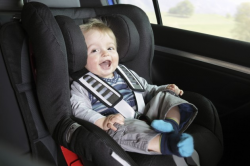
— Summer heat always brings government warnings about the serious danger of leaving a child in a hot car, whether intentionally or unintentionally.
According to statistics from the National Highway Traffic Safety Administration (NHTSA,) over 527 children under age 14 have died of heat stroke in cars since 1998. About 75 percent of the fatalities were children under two years old.
When most people think of leaving a child in a hot car, images of negligent uncaring caregivers or parents typically come to mind. While it's true some people have been charged with a crime, the vast majority of incidents are classified as horrific accidents.
NHTSA says about 51 percent of fatalities occur because a parent or caregiver simply forgets about the child. People from all walks of life have left children in hot cars, much of the problem attributed to stress, hectic lifestyles or even a basic change in routine.
About 17 percent of fatalities involve an adult leaving a child in a car on purpose, but not for the purpose of intentionally harming the child.
Most of these incidents are attributed to ignorance of how quickly the temperature can increase in a car, even on a mild day with the windows partially down. Research has proved temps inside a car can easily hit 120 degrees even if it's 70 degrees outside.
Then there are the approximately 30 percent of children who die of heat stroke because the child enters an unlocked vehicle and for whatever reason, never exits the vehicle.
In response to the fear of leaving a child in a hot car, companies have marketed products which are meant to prevent these deaths. While the idea behind the products is a noble one, research from NHTSA says these devices are "inconsistent and unreliable" and depending on them is a serious mistake.
The government study started with 18 devices that are designed to prevent children up to 24 months old from being left in a hot car. Out of 18 products three were chosen for the study: the Suddenly Safe Pressure Pad, the ChildMinder Smart Clip System, and the ChildMinder Smart Pad. Researchers said these three were the only products that had technology that sensed the presence of a child in a child restraint.
The Results
Numerous problems were encountered, including how interference from a cell phone could cause the device to malfunction. Researchers found problems with a device continually synching or unsynching and found spilling apple juice or any liquid could cause the devices to fail.
And if you think you're already busy enough, the study showed the caregiver will typically need to spend a lot of time adjusting the position of the child within the child restraint. If you're already tired when you place the child in the car, prepare to be more tired after making sure the product is running and working smoothly.
Keep in mind that even with a device, it won't help in the 30 percent of fatalities that occur because a child enters an unlocked vehicle. The device is also useless for the 17 percent of fatalities that happen because an adult intentionally left the child in the car.
Government researchers are quick to commend the companies that are trying to create a life-saving product. However, NHTSA says it's a mistake to depend on these products.
The government suggests even if you use one of these products, leave yourself other reminders of the child in the car. If heading to work, leave something in the back seat that you will need at work. If that option isn't available, leave a note or stuffed animal in the front seat as a reminder.
Most importantly, never walk away from a vehicle without first looking in the back seat area.




